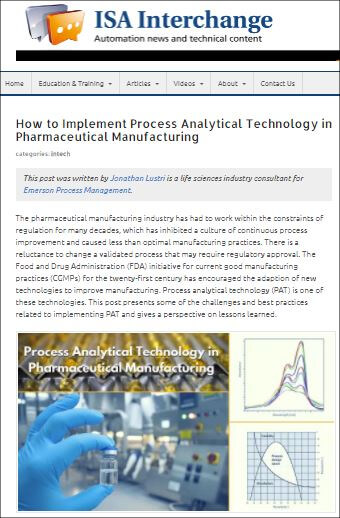In an ISA Intech article, How to Implement Process Analytical Technology in Pharmaceutical Manufacturing, Emerson’s Jonathan Lustri, provides an excellent overview of process analytical technology and how to address the challenges in implementing it.
 Jonathan opens describing the traditional approach to manufacturing quality control. It:
Jonathan opens describing the traditional approach to manufacturing quality control. It:
…is to perform post-quality-control (QC) testing to verify the batch has met critical quality specifications. If quality specifications are not met, the batch is scrapped.
The newer approach encouraged by the FDA is to use:
…a quality-by-design approach by combining a higher level of process understanding with more sophisticated real-time monitoring and control.
Repeatability is difficult for validated processes where continuous process improvement is difficult.
Variability in raw materials, equipment, and processing conditions are unavoidable and will cause variability in product quality. A more robust strategy is to develop processes with measurement and control capabilities that compensate for process variability and to foster a culture of continuous process improvements.
Jonathan explains the relationship between the critical quality attributes (QCAs) developed by the scientists in designing the pharmaceutical products with critical process parameters (CPPs).
This is normally done through a design of experiments, ultimately developing a multivariate model that defines how variability of the CPPs affects the CQAs and the boundaries where the CPPs can operate and produce quality product. The multivariate model that defines the boundaries where the process can operate is known as the design space. It represents a significant component of process understanding.
Once these relationships are understood, implementing PAT-based measurement & control requires:
- analytical instruments
- chemometric modeling tools
- software for PAT method development, data management, and systems integration
He describes the challenges in implementing PAT which includes the use of specialized analyzers, the development of the chemometric models from the analyzer spectral data, PAT method development and execution, integration with the process control system, data management, control strategy development and the attainment of regulatory approvals.
Jonathan provides recommendation on how to successfully overcome these challenges. These include:
- Manage PAT as a strategic initiative
- Do quantified justification
- Do system architecture planning
- Have cross-organizational involvement
- Deploy the right skill sets
- Develop a program plan
Read the article for more on each of these recommendations in planning, executing and delivering the business performance improvements in process analytical technology project. Jonathan concludes:
Deploying PAT as a strategy to increase quality and improve financial performance of drug product and drug substance manufacturing is proven. Many papers are available highlighting successful implementations and the benefits realized. The FDA and other regulatory agencies promote the adoption of new technologies, and the industry is being encouraged to move forward with PAT and other advanced methods for process monitoring and control. As companies decide to adopt these technologies, they should take care to execute investments as part of a strategic initiative and have a realistic understanding of the challenges. Although this is not rocket science, it is chemical science. Obtaining overall organizational commitment and applying good planning and resources are the keys to success.
You can also connect and interact with other pharmaceutical and biotech industry experts in the Life Sciences group in the Emerson Exchange 365 community.





